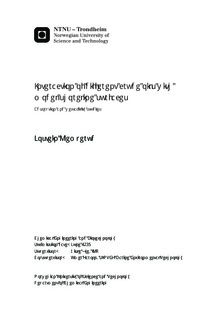| dc.description.abstract | To improve shoreline cleanup operations in the current oil spill response systems, a better understanding of the interactions between the spilled crude oil and the shoreline surfaces is required. The objective of this study was to investigate how the interactions between model shorelines and different crude oils are affected by the difference in chemical composition between the oils. How long the oil has been at sea before the interaction, the weathering of the oil, was also studied. The effects of dispersants (Corexit 9500) and oil-in-seawater emulsification will also be studied.The four crude oils investigated originated from different oil fields, and had different chemical compositions. The different oil types were an asphaltic oil (from the Grane field), a waxy oil (from Norne), a naphthenic oil (from Gullfaks A) and a paraffinic oil (from Oseberg). Fresh and weathered fractions from each field were studied. The shoreline was modeled by quartz crystals with different types of coatings; silica, calcium carbonate and aluminosilicate. The parameters investigated in the study were mass adsorption of oil on the crystals, and the wettability of sea water on the oil covered crystals. The mass adsorption was measured using Quartz Crystal Microbalance with Dissipation (QCM-D), and the wettability was measured by the contact angle of seawater on the oil coated crystals using CAM 200.The results show that the asphaltic Grane oil adsorbed the most on the silica coated crystal, whilst the aluminosilicate coating tended to adsorbed more of the other oil types as well. The calcium carbonate coated crystal also adsorbed a great deal of the Grane oil, but also adsorbed the paraffinic Oseberg oil to a great extent. The dissipation measured simultaneously with the mass adsorption showed that most of the oils adsorbed as a compact and rigid layer. For the wettability of the oil types, this seemed to follow adsorption; high mass adsorption gave a low wettability of seawater on the oil covered crystals, especially for the silica and calcium carbonate coated crystals.With regards to weathering, some trends were observed. For the silica coating, the adsorption of the Norne, Oseberg and Grane oil tended to increase with increased weathering. On the aluminosilicate coating, the adsorption of the Grane oil also increased, whilst the Norne and Oseberg values decreased. For the crystals with the calcium carbonate coating, the Norne adsorption value increased, whilst the Oseberg and Grane values decreased. For all coatings, the Gullfaks A oil tended to change less than the other oil types when introduced to weatheringWhen Corexit 9500 were added, some trends were observed. The mass adsorption of the paraffinic Oseberg oil tended to decrease, whilst the asphaltic Grane oil tended to increase. The other oil types did not have as clear trends. The oil-in-seawater experiments did not give as clear tendencies as in the other experiments. The aluminosilicate coated crystals seemed to adsorb more than the other two crystal coatings, these two coatings tended to adsorb much less than in the other experiments. | nb_NO |

